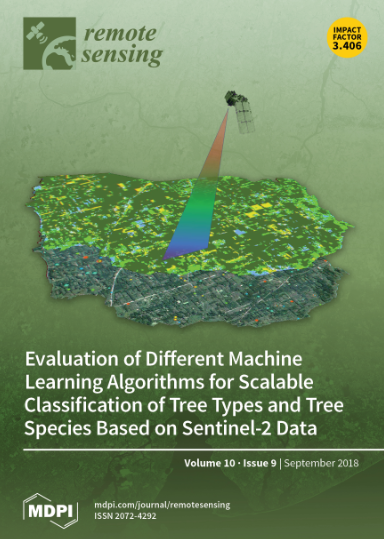Large-Scale Network-Based Observations of a Saharan Dust Event across the European Continent in Spring 2022
IF 4.2
2区 地球科学
Q2 ENVIRONMENTAL SCIENCES
引用次数: 0
Abstract
Between 14 March and 21 April 2022, an extensive investigation of an extraordinary Saharan dust intrusion over Europe was performed based on lidar measurements obtained by the European Aerosol Research Lidar Network (EARLINET). The dust episode was divided into two distinct periods, one in March and one in April, characterized by different dust transport paths. The dust aerosol layers were studied over 18 EARLINET stations, examining aerosol characteristics during March and April in four different regions (M-I, M-II, M-III, and M-IV and A-I, A-II, A-III, and A-IV, respectively), focusing on parameters such as aerosol layer thickness, center of mass (CoM), lidar ratio (LR), particle linear depolarization ratio (PLDR), and Ångström exponents (ÅE). In March, regions exhibited varying dust geometrical and optical properties, with mean CoM values ranging from approximately 3.5 to 4.8 km, and mean LR values typically between 36 and 54 sr. PLDR values indicated the presence of both pure and mixed dust aerosols, with values ranging from 0.20 to 0.32 at 355 nm and 0.24 to 0.31 at 532 nm. ÅE values suggested a range of particle sizes, with some regions showing a predominance of coarse particles. Aerosol Optical Depth (AOD) simulations from the NAAPS model indicated significant dust activity across Europe, with AOD values reaching up to 1.60. In April, dust aerosol layers were observed between 3.2 to 5.2 km. Mean LR values typically ranged from 35 to 51 sr at both 355 nm and 532 nm, while PLDR values confirmed the presence of dust aerosols, with mean values between 0.22 and 0.31 at 355 nm and 0.25 to 0.31 at 532 nm. The ÅE values suggested a mixture of particle sizes. The AOD values in April were generally lower, not exceeding 0.8, indicating a less intense dust presence compared to March. The findings highlight spatial and temporal variations in aerosol characteristics across the regions, during the distinctive periods. From 15 to 16 March 2022, Saharan dust significantly reduced UV-B radiation by approximately 14% over the ATZ station (Athens, GR). Backward air mass trajectories showed that the dust originated from the Western and Central Sahara when, during this specific case, the air mass trajectories passed over GRA (Granada, ES) and PAY (Payerne, CH) before reaching ATZ, maintaining high relative humidity and almost stable aerosol properties throughout its transport. Lidar data revealed elevated aerosol backscatter (baer) and PLDR values, combined with low LR and ÅE values, indicative of pure dust aerosols.基于网络的 2022 年春季欧洲大陆撒哈拉沙尘事件大规模观测数据
2022 年 3 月 14 日至 4 月 21 日期间,根据欧洲气溶胶研究激光雷达网络(EARLINET)获得的激光雷达测量数据,对欧洲上空的一次异常撒哈拉沙尘入侵进行了广泛调查。沙尘事件被分为两个不同的时期,一个在 3 月,一个在 4 月,其特点是沙尘传输路径不同。在 18 个 EARLINET 站对沙尘气溶胶层进行了研究,考察了 4 个不同区域(分别为 M-I、M-II、M-III 和 M-IV 以及 A-I、A-II、A-III 和 A-IV)在 3 月和 4 月期间的气溶胶特征,重点考察了气溶胶层厚度、质量中心(CoM)、激光雷达比率(LR)、粒子线性去极化比率(PLDR)和埃斯特朗指数(ÅE)等参数。PLDR 值表明存在纯尘埃气溶胶和混合尘埃气溶胶,355 纳米波段的 PLDR 值在 0.20 到 0.32 之间,532 纳米波段的 PLDR 值在 0.24 到 0.31 之间。ÅE 值表明存在各种粒径,某些区域以粗颗粒为主。NAAPS 模式的气溶胶光学深度(AOD)模拟显示,整个欧洲的沙尘活动显著,AOD 值高达 1.60。四月份,在 3.2 至 5.2 千米之间观测到了尘埃气溶胶层。355 nm 和 532 nm 波长的平均 LR 值通常在 35 到 51 sr 之间,而 PLDR 值证实了尘埃气溶胶的存在,355 nm 波长的平均值在 0.22 到 0.31 之间,532 nm 波长的平均值在 0.25 到 0.31 之间。ÅE 值表明存在各种粒径的颗粒。4 月份的 AOD 值普遍较低,不超过 0.8,表明与 3 月份相比,沙尘的强度较低。研究结果凸显了各地区气溶胶特征在不同时期的时空变化。2022 年 3 月 15 日至 16 日,撒哈拉沙尘使 ATZ 站(希腊雅典)上空的紫外线-B 辐射显著降低了约 14%。后向气团轨迹显示,沙尘来自撒哈拉西部和中部,在这一特定情况下,气团轨迹在到达 ATZ 站之前经过了 GRA(格拉纳达,西班牙)和 PAY(帕耶内,瑞士),在整个传输过程中保持了较高的相对湿度和几乎稳定的气溶胶特性。激光雷达数据显示,气溶胶后向散射(baer)和 PLDR 值升高,LR 和 ÅE 值降低,表明气溶胶为纯尘埃。
本文章由计算机程序翻译,如有差异,请以英文原文为准。
求助全文
约1分钟内获得全文
求助全文
来源期刊

Remote Sensing
REMOTE SENSING-
CiteScore
8.30
自引率
24.00%
发文量
5435
审稿时长
20.66 days
期刊介绍:
Remote Sensing (ISSN 2072-4292) publishes regular research papers, reviews, letters and communications covering all aspects of the remote sensing process, from instrument design and signal processing to the retrieval of geophysical parameters and their application in geosciences. Our aim is to encourage scientists to publish experimental, theoretical and computational results in as much detail as possible so that results can be easily reproduced. There is no restriction on the length of the papers. The full experimental details must be provided so that the results can be reproduced.
 求助内容:
求助内容: 应助结果提醒方式:
应助结果提醒方式:


